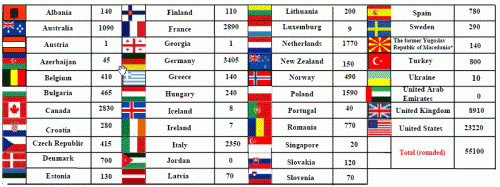The United States has committed to an additional 30,000 troops for the Afghanistan mission and NATO secretary general Jaap de Hoop Scheffer has called on Europe to step up with a similar commitment.
France has already said no. General David Petraeus asked again and was again rebuffed.
Today, Spain joined them.
Spain has no plans to raise its troop levels in Afghanistan despite calls by President Barack Obama for a renewed commitment to fight the resurgent Taliban, Spain’s foreign minister said Tuesday. The comments by Miguel Angel Moratinos are sure to be unwelcome in Washington, which has made shifting military assets from Iraq to Afghanistan a priority, and has called on NATO allies in Europe to contribute to the effort.
Spain already has 800 troops stationed in Afghanistan, mostly in the relatively peaceful Western part of the country, part of a 55,000-strong NATO contingent. “We don’t plan for the moment to increase our military presence in Afghanistan,” Moratinos told journalists at a breakfast meeting.
A token force of 1/70th of those already committed — and well below 1 percent of the force if the Obama expansion goes forward — is hardly “sharing the heavy lifting.”
One ally who is still willing to share the burden is, alas, not in Europe.
Canadian Defense Minister Peter MacKay said on Monday that the rising cost of the country’s military mission in Afghanistan was worth the expense, even though the economic crisis is starting to bite hard.
Skeptical opposition legislators grilled MacKay over why, at a time of big budget deficits and soaring unemployment, Ottawa was pouring billions of dollars into a combat mission that critics say shows few signs of success. Last October, Parliament’s budgetary officer said the mission could cost C$18 billion ($15 billion) if Canada’s 2,700 troops stayed until the end of 2011 as planned.
“Afghanistan was the largest exporter of terror in our lifetime so our efforts there to bring about some semblance of security and democracy continue to be a very worthy cause,” MacKay told reporters. “Now that’s costly. A military mission by its very nature is expensive … but we are making gains,” he said after testifying to Parliament’s defense committee.
The table below breaks down the country-by-country participation in ISAF, current as of 12 January 2009, provided by NATO [PDF]:

This, of course, isn’t a perfect portrayal of the troop commitment, as there are non-ISAF forces in the country. Despite the impressive array of countries, the United States and the United Kingdom continue to dominate the force structure. It’s admirable that several of the emerging democracies in eastern Europe are participating at all, even in symbolic numbers. But several traditional powers are doing far less than their fair share.
James Joyner is managing editor of the Atlantic Council.
